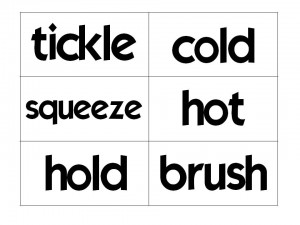Merry Christmas! I’m spending this week with my husband’s family in Connecticut. I’m posting a few of my favorite blog posts in case you missed them during this time. I’ll be back after the Holidays with some more (finally) cuing posts as well as a THREE YEAR blogging celebration in January. Check back for some awesome prizes and fun contests. Anybody like Cariboo?
************************************************************************************************************************************************************
One of the things that can be so frustrating when working with children with significant communication challenges, is trying to determine HOW they are feeling. Frequently, parents will tell me that they wish their child could TELL them if they were in pain or hurting. Generally, I think these clients do tell us when they are sick or not feeling well. Sudden changes in behavior or compliance can signal that the child is not feeling well. This is simply their way of letting us know. The problem is that they can’t get specific: I have a headache, my tummy hurts, etc. Parents and professionals need to be detectives to try to determine what could possibly be troubling the child. If he or she pulls at their ears could it be an ear infection? I cannot imagine how frustrating and heartbreaking it must when you aren’t able to figure it out or help your child get better.
So is there a way to teach the child to communicate what or where they are experiencing pain? I’m not sure. In the past, I’ve used bandaids to “role play” something being hurt and then had the child “tell” me either verbally, or using pictures or an augmentative communication device. The problem is that this is role play, and I’m not always sure if the client understands or is able to make the connection between the activity and real life pain. Obviously you are limited in your ability to “teach” or demonstrate what pain looks like.
But what if we could get the child to associate other sensations with parts of their body, then could we get them to eventually associate pain as well. Here’s my plan:
1. Start by taking a picture of the whole child’s body. I did this on the I-pad. Or you can draw a picture of a body-I just think it’s more fun to have the photo.
2. Get a box of different textures or feels. I used a “furry” stuffed animal, ice pack, and tape to start.
3. The client I was working with was able to read, so I paired the activity with written word cards. You could also use Boardmaker PCS symbols. Click on the picture below to download…
4. Using the pictures, I started modeling the activity using the cold pack and tickle. “Tickle on shoulder,” “Cold on knee.” etc. I paired each activity with the written cards. Placing the card on the picture of the body, and then demonstrating on the client.
5. Then I placed the 2 cards out to see if the client was able to request preferred sensory input and a location.
Some other ideas to expand on this activity I had:
1. Have the child point to the body picture and then add the sensory experience there.
2. Apply the sensory input and then have the child point or label where they are feeling the sensory input.
3. For children who need more work on body parts, you could also have stickers that you place on their picture and then place on their body part.
4. Have parents make a giant picture of their child to work on what hurts at home. I think some of the big box stores such as Costco/Sam’s Club have reasonable prices on 16×20 pictures.
I’m interested in hearing from you. What ideas have you tried that have helped to work on teaching a child how to communicate pain.




Amazing suggestions! You are an amazingly gifted SLP!!!
Thanks Annie!